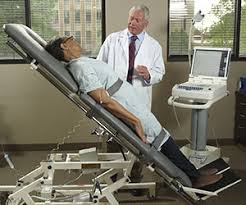 A tilt table test is used in patients being evaluated for a hemodynamic response to the downward displacement of intravascular volume and movement from the supine to upright position.
A tilt table test is used in patients being evaluated for a hemodynamic response to the downward displacement of intravascular volume and movement from the supine to upright position.
A tilt table test, also known as a head-up tilt test.
It is medical procedure used to evaluate unexplained episodes of lightheadedness, dizziness, or syncope.
It is particularly useful in diagnosing conditions related to problems with the autonomic nervous system’s regulation of blood pressure and heart rate.
The tilt table test aims to reproduce the patient’s symptoms in a controlled environment while monitoring their vital signs.
This can help diagnose conditions such as vasovagal syncope, postural orthostatic tachycardia syndrome (POTS), and other forms of dysautonomia.
The results of the tilt table test, combined with the patient’s medical history and other tests, can help determine the underlying cause of the symptoms and develop an appropriate treatment plan.
With a tilt table test movement from horizontal to upright position, normally provokes increased sympathetic adrenergic outflow to sustain cardiac output.
A normal response to a test is a mild decrease in blood pressure with a decline in systolic blood pressure of less than 20 mmHg, and a decline in diastolic pressure of less than 10 mmHg, and the mild increase in heart rate of less than 30 bpm.
The table test evaluates patients with syncope of unknown cause, suspected vasovagal, or orthostatic syncope, and or autonomic dysfunction, including orthostatic hypotension and postural orthostatic tachycardia syndrome.
The patients abstain from alcohol and caffeine for 12 hours and fast for at least two hours prior to the test.
Patients are monitored with continuous EKG, and frequent blood pressure monitoring.
The test begins after the patient is supine for at least 10 minutes and the table moves into a 70° incline within 10 seconds.
The duration of the tilt table test ranges from 5 to 45 minutes, depending upon the underlying clinical process.
False positive test occur in 10 to 15% of asymptomatic control patients.
The table test is contraindicated, in pregnancy, and those with severe coronary artery or cerebral vascular disease, because hypotension may be precipitated with myocardial or cerebral ischemia.
